Strategic Planning and Management for Guna Fibers
VerifiedAdded on 2022/11/14
|16
|3483
|100
AI Summary
This document provides an analysis of the strategic planning and management of Guna Fibers, including external and internal analysis, SWOT analysis, value chain analysis, BCG matrix, balanced scorecard, accounting ratios, strategic choices, and change management.
Contribute Materials
Your contribution can guide someone’s learning journey. Share your
documents today.
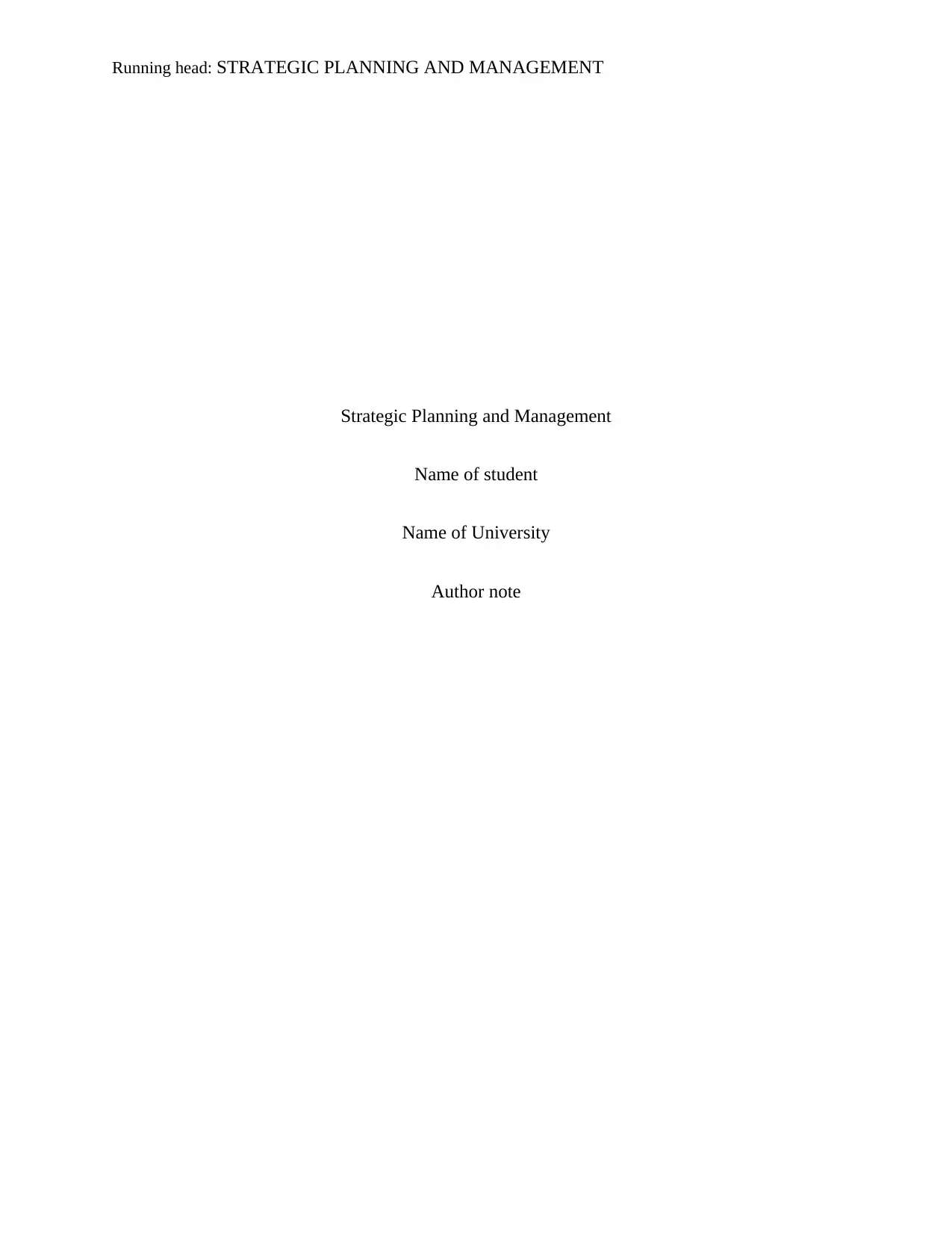
Running head: STRATEGIC PLANNING AND MANAGEMENT
Strategic Planning and Management
Name of student
Name of University
Author note
Strategic Planning and Management
Name of student
Name of University
Author note
Secure Best Marks with AI Grader
Need help grading? Try our AI Grader for instant feedback on your assignments.
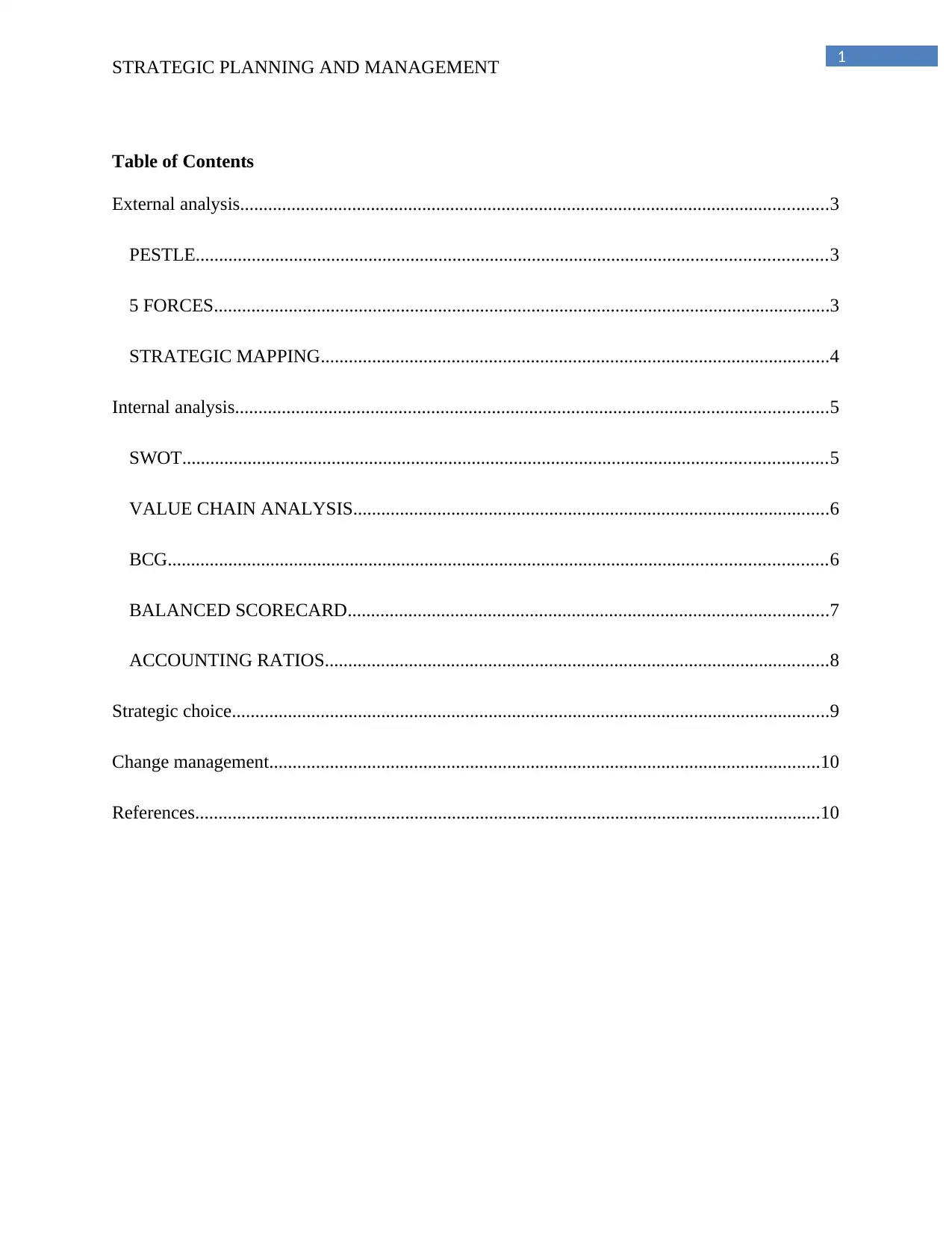
1
STRATEGIC PLANNING AND MANAGEMENT
Table of Contents
External analysis..............................................................................................................................3
PESTLE.......................................................................................................................................3
5 FORCES....................................................................................................................................3
STRATEGIC MAPPING.............................................................................................................4
Internal analysis...............................................................................................................................5
SWOT..........................................................................................................................................5
VALUE CHAIN ANALYSIS......................................................................................................6
BCG.............................................................................................................................................6
BALANCED SCORECARD.......................................................................................................7
ACCOUNTING RATIOS............................................................................................................8
Strategic choice................................................................................................................................9
Change management......................................................................................................................10
References......................................................................................................................................10
STRATEGIC PLANNING AND MANAGEMENT
Table of Contents
External analysis..............................................................................................................................3
PESTLE.......................................................................................................................................3
5 FORCES....................................................................................................................................3
STRATEGIC MAPPING.............................................................................................................4
Internal analysis...............................................................................................................................5
SWOT..........................................................................................................................................5
VALUE CHAIN ANALYSIS......................................................................................................6
BCG.............................................................................................................................................6
BALANCED SCORECARD.......................................................................................................7
ACCOUNTING RATIOS............................................................................................................8
Strategic choice................................................................................................................................9
Change management......................................................................................................................10
References......................................................................................................................................10
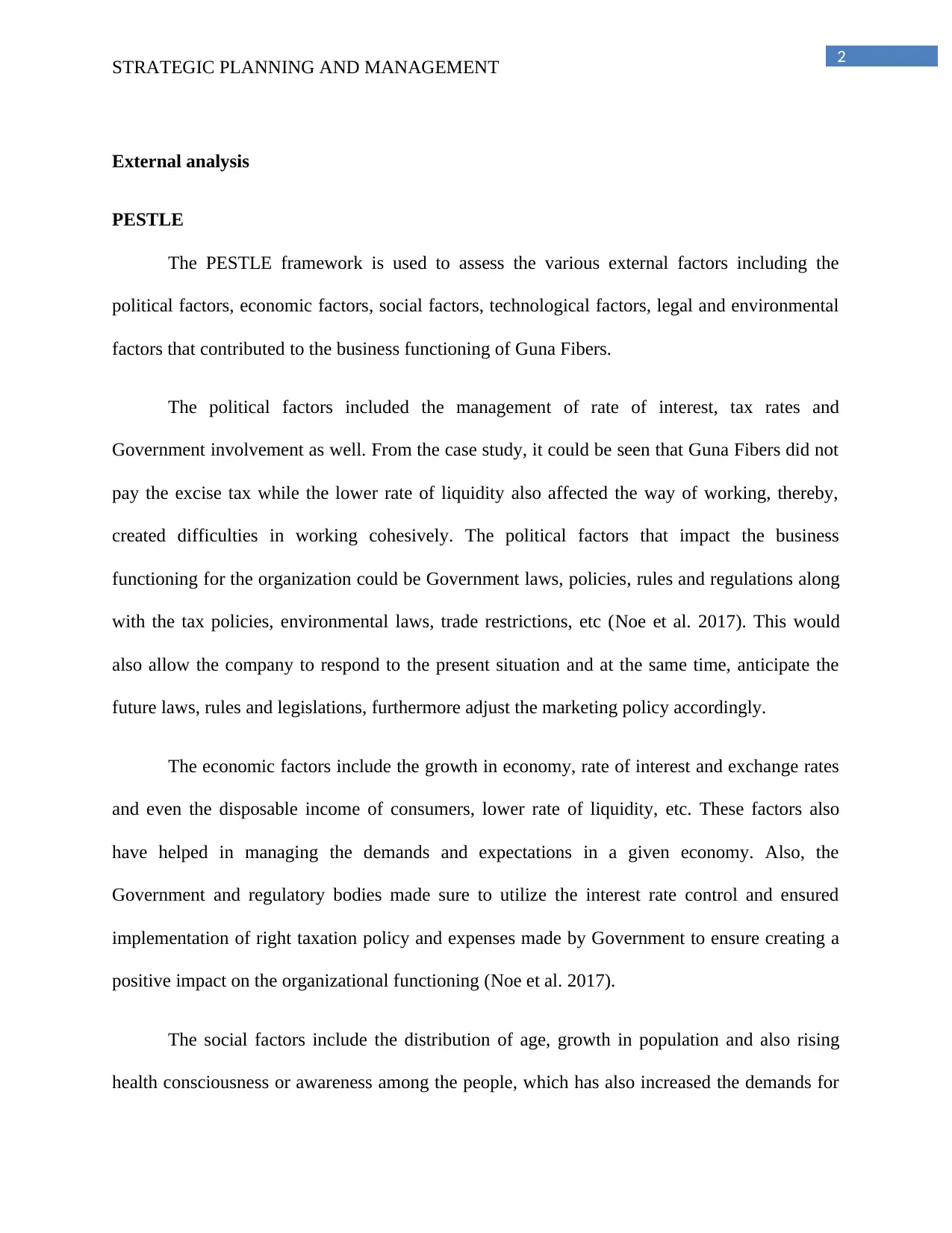
2
STRATEGIC PLANNING AND MANAGEMENT
External analysis
PESTLE
The PESTLE framework is used to assess the various external factors including the
political factors, economic factors, social factors, technological factors, legal and environmental
factors that contributed to the business functioning of Guna Fibers.
The political factors included the management of rate of interest, tax rates and
Government involvement as well. From the case study, it could be seen that Guna Fibers did not
pay the excise tax while the lower rate of liquidity also affected the way of working, thereby,
created difficulties in working cohesively. The political factors that impact the business
functioning for the organization could be Government laws, policies, rules and regulations along
with the tax policies, environmental laws, trade restrictions, etc (Noe et al. 2017). This would
also allow the company to respond to the present situation and at the same time, anticipate the
future laws, rules and legislations, furthermore adjust the marketing policy accordingly.
The economic factors include the growth in economy, rate of interest and exchange rates
and even the disposable income of consumers, lower rate of liquidity, etc. These factors also
have helped in managing the demands and expectations in a given economy. Also, the
Government and regulatory bodies made sure to utilize the interest rate control and ensured
implementation of right taxation policy and expenses made by Government to ensure creating a
positive impact on the organizational functioning (Noe et al. 2017).
The social factors include the distribution of age, growth in population and also rising
health consciousness or awareness among the people, which has also increased the demands for
STRATEGIC PLANNING AND MANAGEMENT
External analysis
PESTLE
The PESTLE framework is used to assess the various external factors including the
political factors, economic factors, social factors, technological factors, legal and environmental
factors that contributed to the business functioning of Guna Fibers.
The political factors included the management of rate of interest, tax rates and
Government involvement as well. From the case study, it could be seen that Guna Fibers did not
pay the excise tax while the lower rate of liquidity also affected the way of working, thereby,
created difficulties in working cohesively. The political factors that impact the business
functioning for the organization could be Government laws, policies, rules and regulations along
with the tax policies, environmental laws, trade restrictions, etc (Noe et al. 2017). This would
also allow the company to respond to the present situation and at the same time, anticipate the
future laws, rules and legislations, furthermore adjust the marketing policy accordingly.
The economic factors include the growth in economy, rate of interest and exchange rates
and even the disposable income of consumers, lower rate of liquidity, etc. These factors also
have helped in managing the demands and expectations in a given economy. Also, the
Government and regulatory bodies made sure to utilize the interest rate control and ensured
implementation of right taxation policy and expenses made by Government to ensure creating a
positive impact on the organizational functioning (Noe et al. 2017).
The social factors include the distribution of age, growth in population and also rising
health consciousness or awareness among the people, which has also increased the demands for
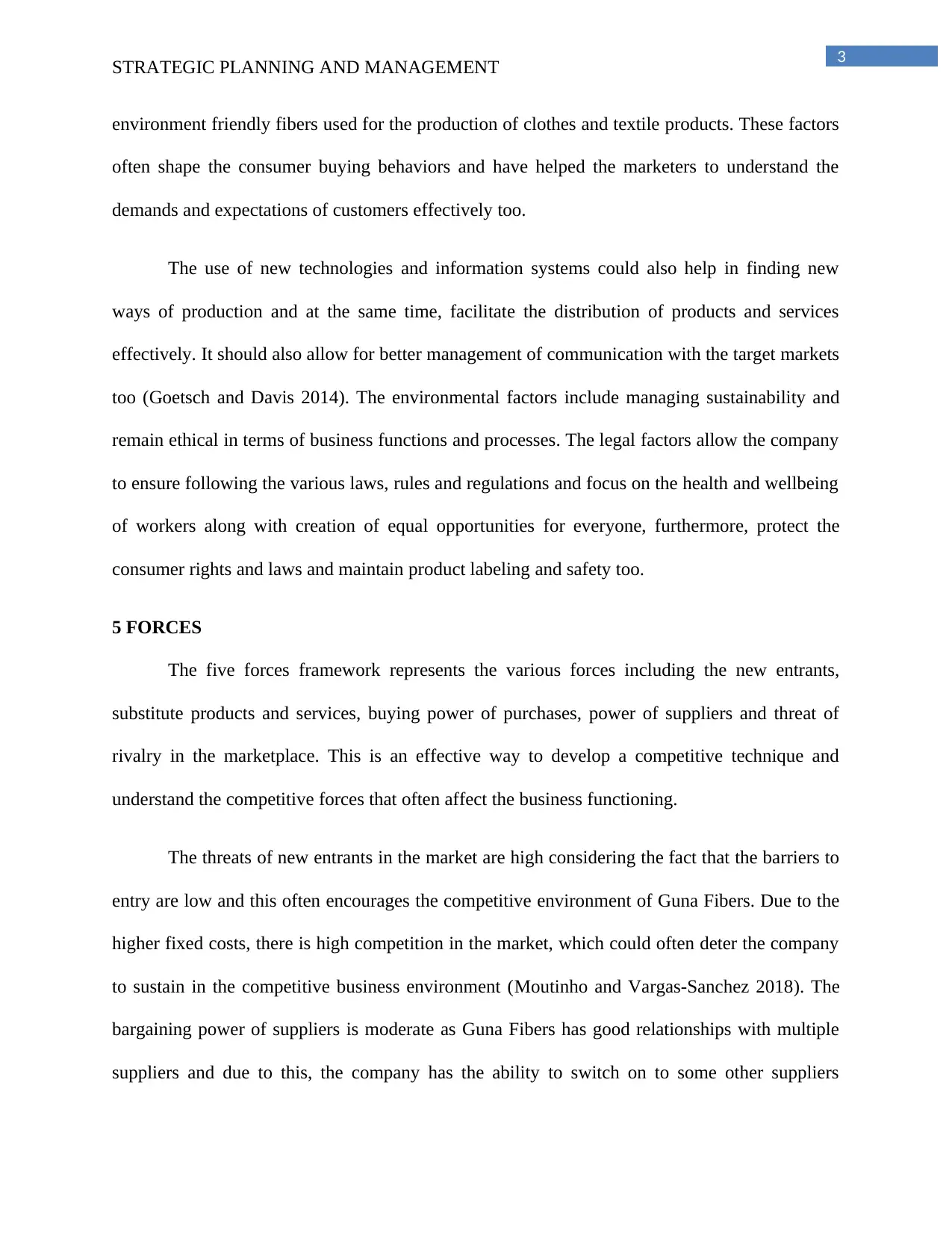
3
STRATEGIC PLANNING AND MANAGEMENT
environment friendly fibers used for the production of clothes and textile products. These factors
often shape the consumer buying behaviors and have helped the marketers to understand the
demands and expectations of customers effectively too.
The use of new technologies and information systems could also help in finding new
ways of production and at the same time, facilitate the distribution of products and services
effectively. It should also allow for better management of communication with the target markets
too (Goetsch and Davis 2014). The environmental factors include managing sustainability and
remain ethical in terms of business functions and processes. The legal factors allow the company
to ensure following the various laws, rules and regulations and focus on the health and wellbeing
of workers along with creation of equal opportunities for everyone, furthermore, protect the
consumer rights and laws and maintain product labeling and safety too.
5 FORCES
The five forces framework represents the various forces including the new entrants,
substitute products and services, buying power of purchases, power of suppliers and threat of
rivalry in the marketplace. This is an effective way to develop a competitive technique and
understand the competitive forces that often affect the business functioning.
The threats of new entrants in the market are high considering the fact that the barriers to
entry are low and this often encourages the competitive environment of Guna Fibers. Due to the
higher fixed costs, there is high competition in the market, which could often deter the company
to sustain in the competitive business environment (Moutinho and Vargas-Sanchez 2018). The
bargaining power of suppliers is moderate as Guna Fibers has good relationships with multiple
suppliers and due to this, the company has the ability to switch on to some other suppliers
STRATEGIC PLANNING AND MANAGEMENT
environment friendly fibers used for the production of clothes and textile products. These factors
often shape the consumer buying behaviors and have helped the marketers to understand the
demands and expectations of customers effectively too.
The use of new technologies and information systems could also help in finding new
ways of production and at the same time, facilitate the distribution of products and services
effectively. It should also allow for better management of communication with the target markets
too (Goetsch and Davis 2014). The environmental factors include managing sustainability and
remain ethical in terms of business functions and processes. The legal factors allow the company
to ensure following the various laws, rules and regulations and focus on the health and wellbeing
of workers along with creation of equal opportunities for everyone, furthermore, protect the
consumer rights and laws and maintain product labeling and safety too.
5 FORCES
The five forces framework represents the various forces including the new entrants,
substitute products and services, buying power of purchases, power of suppliers and threat of
rivalry in the marketplace. This is an effective way to develop a competitive technique and
understand the competitive forces that often affect the business functioning.
The threats of new entrants in the market are high considering the fact that the barriers to
entry are low and this often encourages the competitive environment of Guna Fibers. Due to the
higher fixed costs, there is high competition in the market, which could often deter the company
to sustain in the competitive business environment (Moutinho and Vargas-Sanchez 2018). The
bargaining power of suppliers is moderate as Guna Fibers has good relationships with multiple
suppliers and due to this, the company has the ability to switch on to some other suppliers
Secure Best Marks with AI Grader
Need help grading? Try our AI Grader for instant feedback on your assignments.
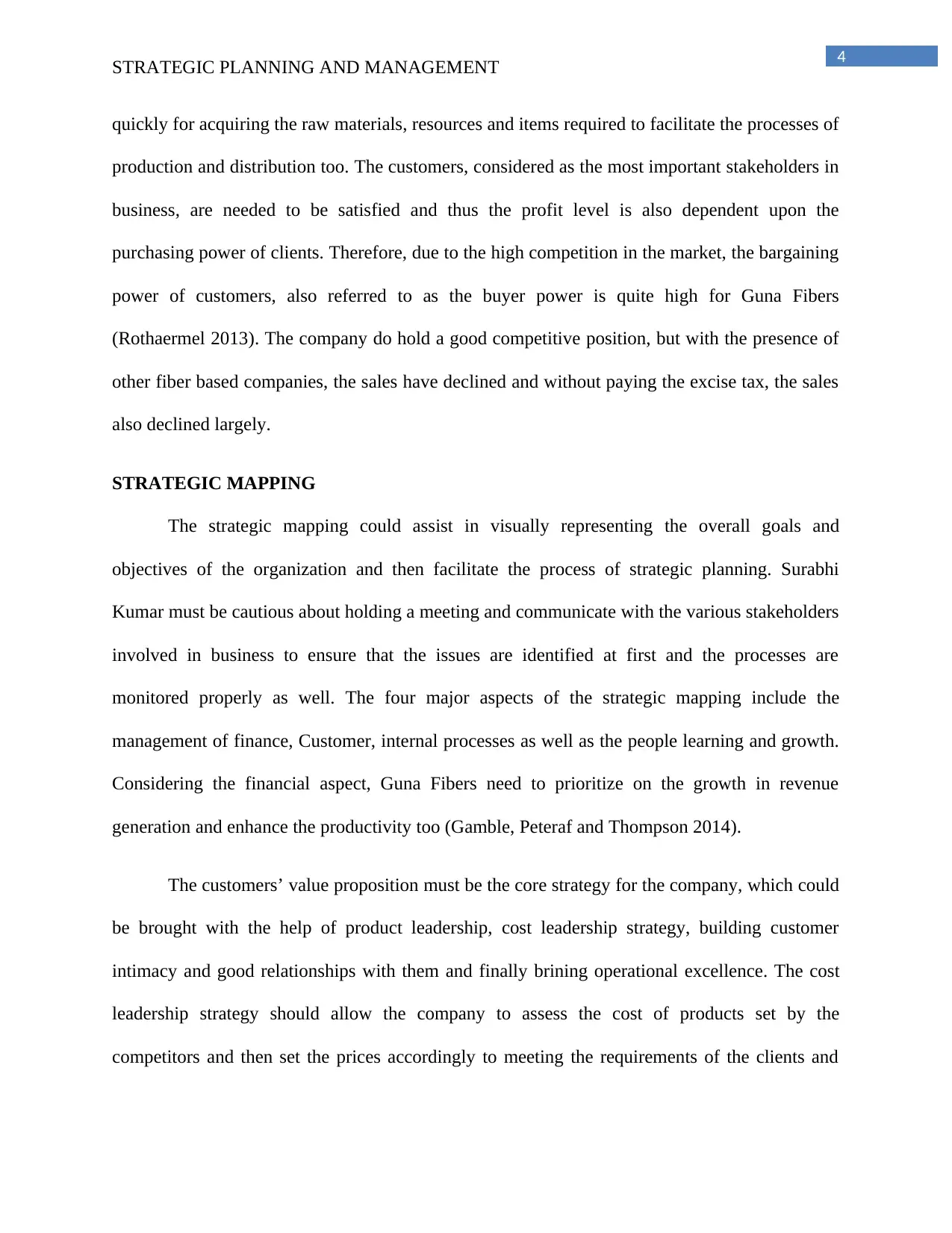
4
STRATEGIC PLANNING AND MANAGEMENT
quickly for acquiring the raw materials, resources and items required to facilitate the processes of
production and distribution too. The customers, considered as the most important stakeholders in
business, are needed to be satisfied and thus the profit level is also dependent upon the
purchasing power of clients. Therefore, due to the high competition in the market, the bargaining
power of customers, also referred to as the buyer power is quite high for Guna Fibers
(Rothaermel 2013). The company do hold a good competitive position, but with the presence of
other fiber based companies, the sales have declined and without paying the excise tax, the sales
also declined largely.
STRATEGIC MAPPING
The strategic mapping could assist in visually representing the overall goals and
objectives of the organization and then facilitate the process of strategic planning. Surabhi
Kumar must be cautious about holding a meeting and communicate with the various stakeholders
involved in business to ensure that the issues are identified at first and the processes are
monitored properly as well. The four major aspects of the strategic mapping include the
management of finance, Customer, internal processes as well as the people learning and growth.
Considering the financial aspect, Guna Fibers need to prioritize on the growth in revenue
generation and enhance the productivity too (Gamble, Peteraf and Thompson 2014).
The customers’ value proposition must be the core strategy for the company, which could
be brought with the help of product leadership, cost leadership strategy, building customer
intimacy and good relationships with them and finally brining operational excellence. The cost
leadership strategy should allow the company to assess the cost of products set by the
competitors and then set the prices accordingly to meeting the requirements of the clients and
STRATEGIC PLANNING AND MANAGEMENT
quickly for acquiring the raw materials, resources and items required to facilitate the processes of
production and distribution too. The customers, considered as the most important stakeholders in
business, are needed to be satisfied and thus the profit level is also dependent upon the
purchasing power of clients. Therefore, due to the high competition in the market, the bargaining
power of customers, also referred to as the buyer power is quite high for Guna Fibers
(Rothaermel 2013). The company do hold a good competitive position, but with the presence of
other fiber based companies, the sales have declined and without paying the excise tax, the sales
also declined largely.
STRATEGIC MAPPING
The strategic mapping could assist in visually representing the overall goals and
objectives of the organization and then facilitate the process of strategic planning. Surabhi
Kumar must be cautious about holding a meeting and communicate with the various stakeholders
involved in business to ensure that the issues are identified at first and the processes are
monitored properly as well. The four major aspects of the strategic mapping include the
management of finance, Customer, internal processes as well as the people learning and growth.
Considering the financial aspect, Guna Fibers need to prioritize on the growth in revenue
generation and enhance the productivity too (Gamble, Peteraf and Thompson 2014).
The customers’ value proposition must be the core strategy for the company, which could
be brought with the help of product leadership, cost leadership strategy, building customer
intimacy and good relationships with them and finally brining operational excellence. The cost
leadership strategy should allow the company to assess the cost of products set by the
competitors and then set the prices accordingly to meeting the requirements of the clients and
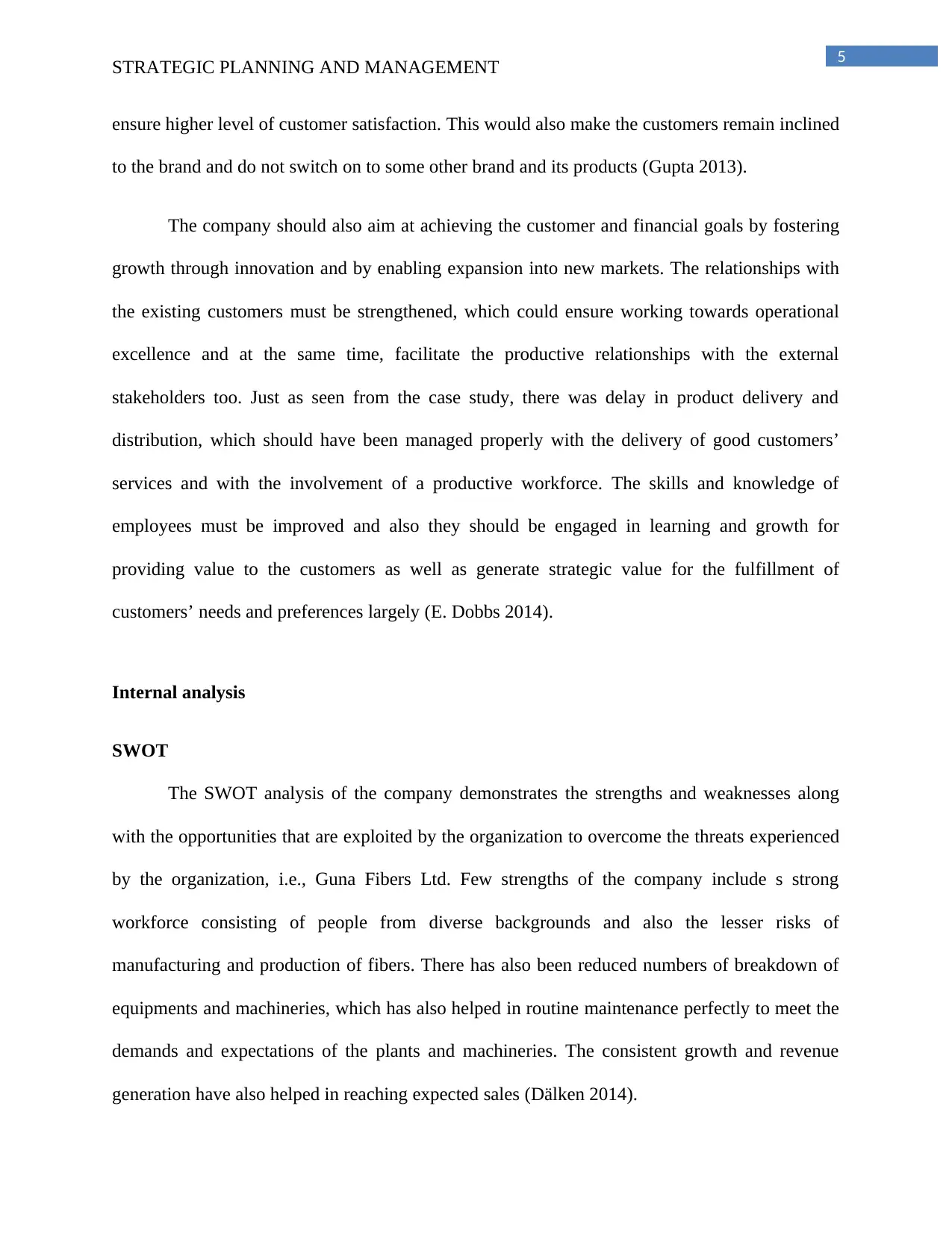
5
STRATEGIC PLANNING AND MANAGEMENT
ensure higher level of customer satisfaction. This would also make the customers remain inclined
to the brand and do not switch on to some other brand and its products (Gupta 2013).
The company should also aim at achieving the customer and financial goals by fostering
growth through innovation and by enabling expansion into new markets. The relationships with
the existing customers must be strengthened, which could ensure working towards operational
excellence and at the same time, facilitate the productive relationships with the external
stakeholders too. Just as seen from the case study, there was delay in product delivery and
distribution, which should have been managed properly with the delivery of good customers’
services and with the involvement of a productive workforce. The skills and knowledge of
employees must be improved and also they should be engaged in learning and growth for
providing value to the customers as well as generate strategic value for the fulfillment of
customers’ needs and preferences largely (E. Dobbs 2014).
Internal analysis
SWOT
The SWOT analysis of the company demonstrates the strengths and weaknesses along
with the opportunities that are exploited by the organization to overcome the threats experienced
by the organization, i.e., Guna Fibers Ltd. Few strengths of the company include s strong
workforce consisting of people from diverse backgrounds and also the lesser risks of
manufacturing and production of fibers. There has also been reduced numbers of breakdown of
equipments and machineries, which has also helped in routine maintenance perfectly to meet the
demands and expectations of the plants and machineries. The consistent growth and revenue
generation have also helped in reaching expected sales (Dälken 2014).
STRATEGIC PLANNING AND MANAGEMENT
ensure higher level of customer satisfaction. This would also make the customers remain inclined
to the brand and do not switch on to some other brand and its products (Gupta 2013).
The company should also aim at achieving the customer and financial goals by fostering
growth through innovation and by enabling expansion into new markets. The relationships with
the existing customers must be strengthened, which could ensure working towards operational
excellence and at the same time, facilitate the productive relationships with the external
stakeholders too. Just as seen from the case study, there was delay in product delivery and
distribution, which should have been managed properly with the delivery of good customers’
services and with the involvement of a productive workforce. The skills and knowledge of
employees must be improved and also they should be engaged in learning and growth for
providing value to the customers as well as generate strategic value for the fulfillment of
customers’ needs and preferences largely (E. Dobbs 2014).
Internal analysis
SWOT
The SWOT analysis of the company demonstrates the strengths and weaknesses along
with the opportunities that are exploited by the organization to overcome the threats experienced
by the organization, i.e., Guna Fibers Ltd. Few strengths of the company include s strong
workforce consisting of people from diverse backgrounds and also the lesser risks of
manufacturing and production of fibers. There has also been reduced numbers of breakdown of
equipments and machineries, which has also helped in routine maintenance perfectly to meet the
demands and expectations of the plants and machineries. The consistent growth and revenue
generation have also helped in reaching expected sales (Dälken 2014).
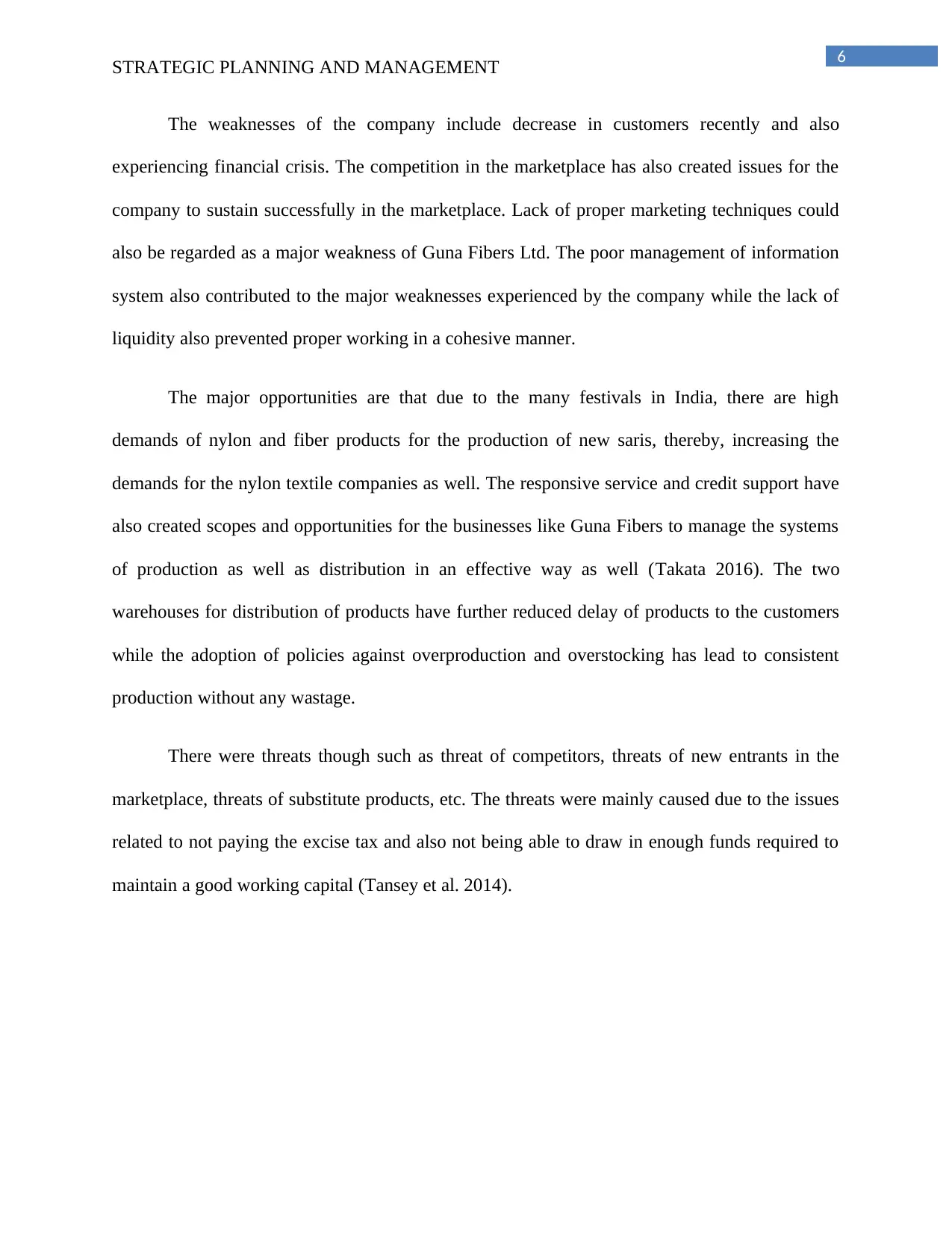
6
STRATEGIC PLANNING AND MANAGEMENT
The weaknesses of the company include decrease in customers recently and also
experiencing financial crisis. The competition in the marketplace has also created issues for the
company to sustain successfully in the marketplace. Lack of proper marketing techniques could
also be regarded as a major weakness of Guna Fibers Ltd. The poor management of information
system also contributed to the major weaknesses experienced by the company while the lack of
liquidity also prevented proper working in a cohesive manner.
The major opportunities are that due to the many festivals in India, there are high
demands of nylon and fiber products for the production of new saris, thereby, increasing the
demands for the nylon textile companies as well. The responsive service and credit support have
also created scopes and opportunities for the businesses like Guna Fibers to manage the systems
of production as well as distribution in an effective way as well (Takata 2016). The two
warehouses for distribution of products have further reduced delay of products to the customers
while the adoption of policies against overproduction and overstocking has lead to consistent
production without any wastage.
There were threats though such as threat of competitors, threats of new entrants in the
marketplace, threats of substitute products, etc. The threats were mainly caused due to the issues
related to not paying the excise tax and also not being able to draw in enough funds required to
maintain a good working capital (Tansey et al. 2014).
STRATEGIC PLANNING AND MANAGEMENT
The weaknesses of the company include decrease in customers recently and also
experiencing financial crisis. The competition in the marketplace has also created issues for the
company to sustain successfully in the marketplace. Lack of proper marketing techniques could
also be regarded as a major weakness of Guna Fibers Ltd. The poor management of information
system also contributed to the major weaknesses experienced by the company while the lack of
liquidity also prevented proper working in a cohesive manner.
The major opportunities are that due to the many festivals in India, there are high
demands of nylon and fiber products for the production of new saris, thereby, increasing the
demands for the nylon textile companies as well. The responsive service and credit support have
also created scopes and opportunities for the businesses like Guna Fibers to manage the systems
of production as well as distribution in an effective way as well (Takata 2016). The two
warehouses for distribution of products have further reduced delay of products to the customers
while the adoption of policies against overproduction and overstocking has lead to consistent
production without any wastage.
There were threats though such as threat of competitors, threats of new entrants in the
marketplace, threats of substitute products, etc. The threats were mainly caused due to the issues
related to not paying the excise tax and also not being able to draw in enough funds required to
maintain a good working capital (Tansey et al. 2014).
Paraphrase This Document
Need a fresh take? Get an instant paraphrase of this document with our AI Paraphraser
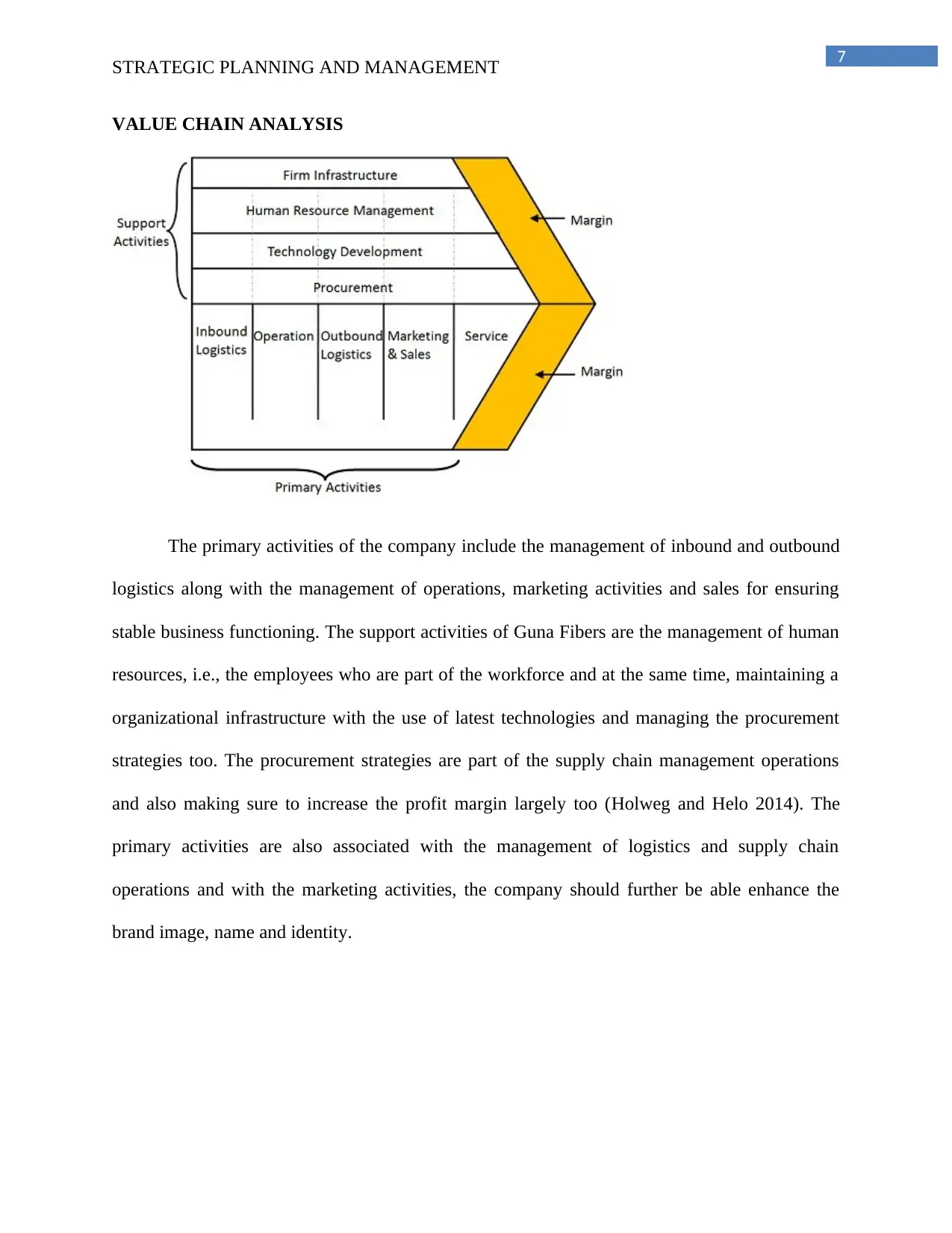
7
STRATEGIC PLANNING AND MANAGEMENT
VALUE CHAIN ANALYSIS
The primary activities of the company include the management of inbound and outbound
logistics along with the management of operations, marketing activities and sales for ensuring
stable business functioning. The support activities of Guna Fibers are the management of human
resources, i.e., the employees who are part of the workforce and at the same time, maintaining a
organizational infrastructure with the use of latest technologies and managing the procurement
strategies too. The procurement strategies are part of the supply chain management operations
and also making sure to increase the profit margin largely too (Holweg and Helo 2014). The
primary activities are also associated with the management of logistics and supply chain
operations and with the marketing activities, the company should further be able enhance the
brand image, name and identity.
STRATEGIC PLANNING AND MANAGEMENT
VALUE CHAIN ANALYSIS
The primary activities of the company include the management of inbound and outbound
logistics along with the management of operations, marketing activities and sales for ensuring
stable business functioning. The support activities of Guna Fibers are the management of human
resources, i.e., the employees who are part of the workforce and at the same time, maintaining a
organizational infrastructure with the use of latest technologies and managing the procurement
strategies too. The procurement strategies are part of the supply chain management operations
and also making sure to increase the profit margin largely too (Holweg and Helo 2014). The
primary activities are also associated with the management of logistics and supply chain
operations and with the marketing activities, the company should further be able enhance the
brand image, name and identity.
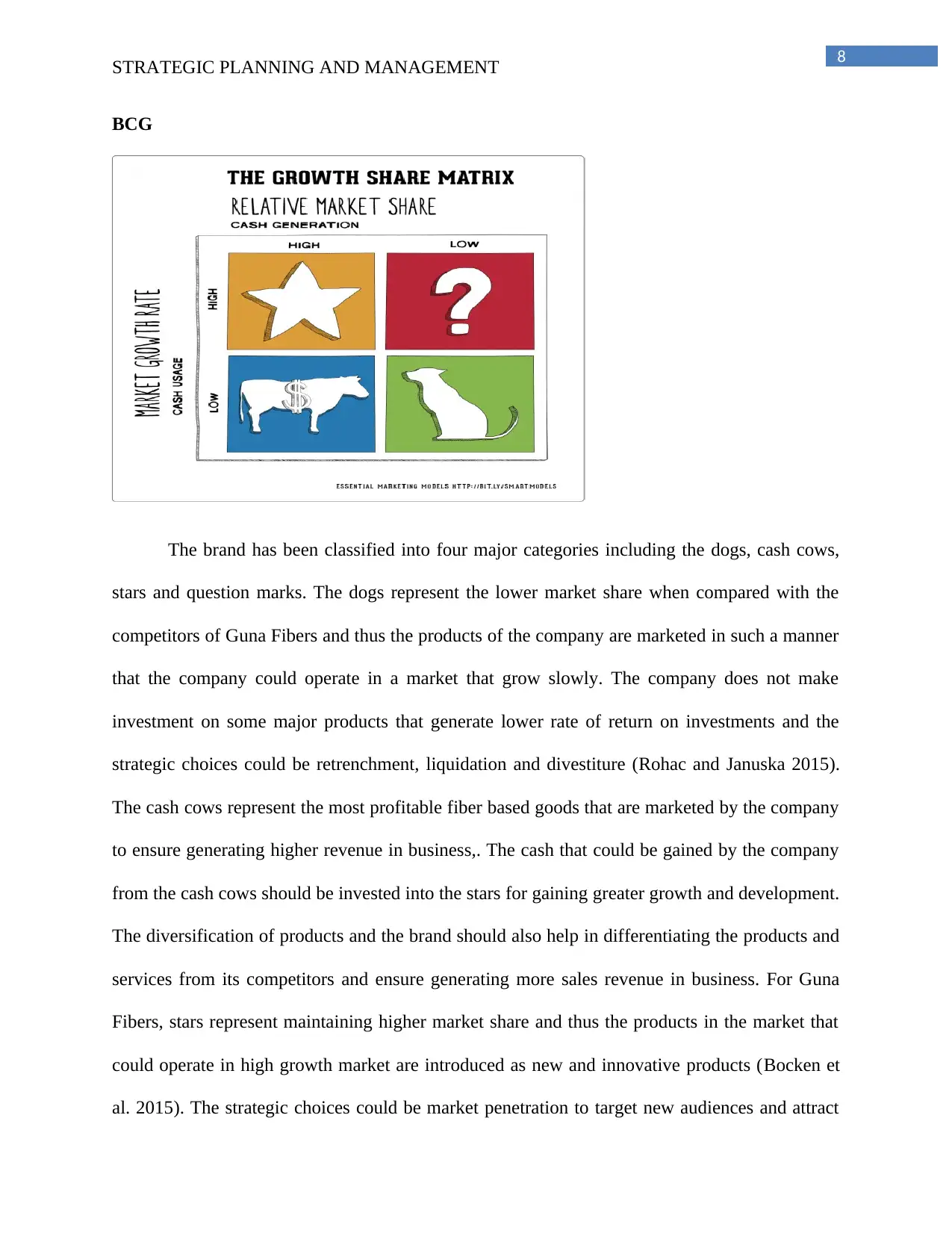
8
STRATEGIC PLANNING AND MANAGEMENT
BCG
The brand has been classified into four major categories including the dogs, cash cows,
stars and question marks. The dogs represent the lower market share when compared with the
competitors of Guna Fibers and thus the products of the company are marketed in such a manner
that the company could operate in a market that grow slowly. The company does not make
investment on some major products that generate lower rate of return on investments and the
strategic choices could be retrenchment, liquidation and divestiture (Rohac and Januska 2015).
The cash cows represent the most profitable fiber based goods that are marketed by the company
to ensure generating higher revenue in business,. The cash that could be gained by the company
from the cash cows should be invested into the stars for gaining greater growth and development.
The diversification of products and the brand should also help in differentiating the products and
services from its competitors and ensure generating more sales revenue in business. For Guna
Fibers, stars represent maintaining higher market share and thus the products in the market that
could operate in high growth market are introduced as new and innovative products (Bocken et
al. 2015). The strategic choices could be market penetration to target new audiences and attract
STRATEGIC PLANNING AND MANAGEMENT
BCG
The brand has been classified into four major categories including the dogs, cash cows,
stars and question marks. The dogs represent the lower market share when compared with the
competitors of Guna Fibers and thus the products of the company are marketed in such a manner
that the company could operate in a market that grow slowly. The company does not make
investment on some major products that generate lower rate of return on investments and the
strategic choices could be retrenchment, liquidation and divestiture (Rohac and Januska 2015).
The cash cows represent the most profitable fiber based goods that are marketed by the company
to ensure generating higher revenue in business,. The cash that could be gained by the company
from the cash cows should be invested into the stars for gaining greater growth and development.
The diversification of products and the brand should also help in differentiating the products and
services from its competitors and ensure generating more sales revenue in business. For Guna
Fibers, stars represent maintaining higher market share and thus the products in the market that
could operate in high growth market are introduced as new and innovative products (Bocken et
al. 2015). The strategic choices could be market penetration to target new audiences and attract
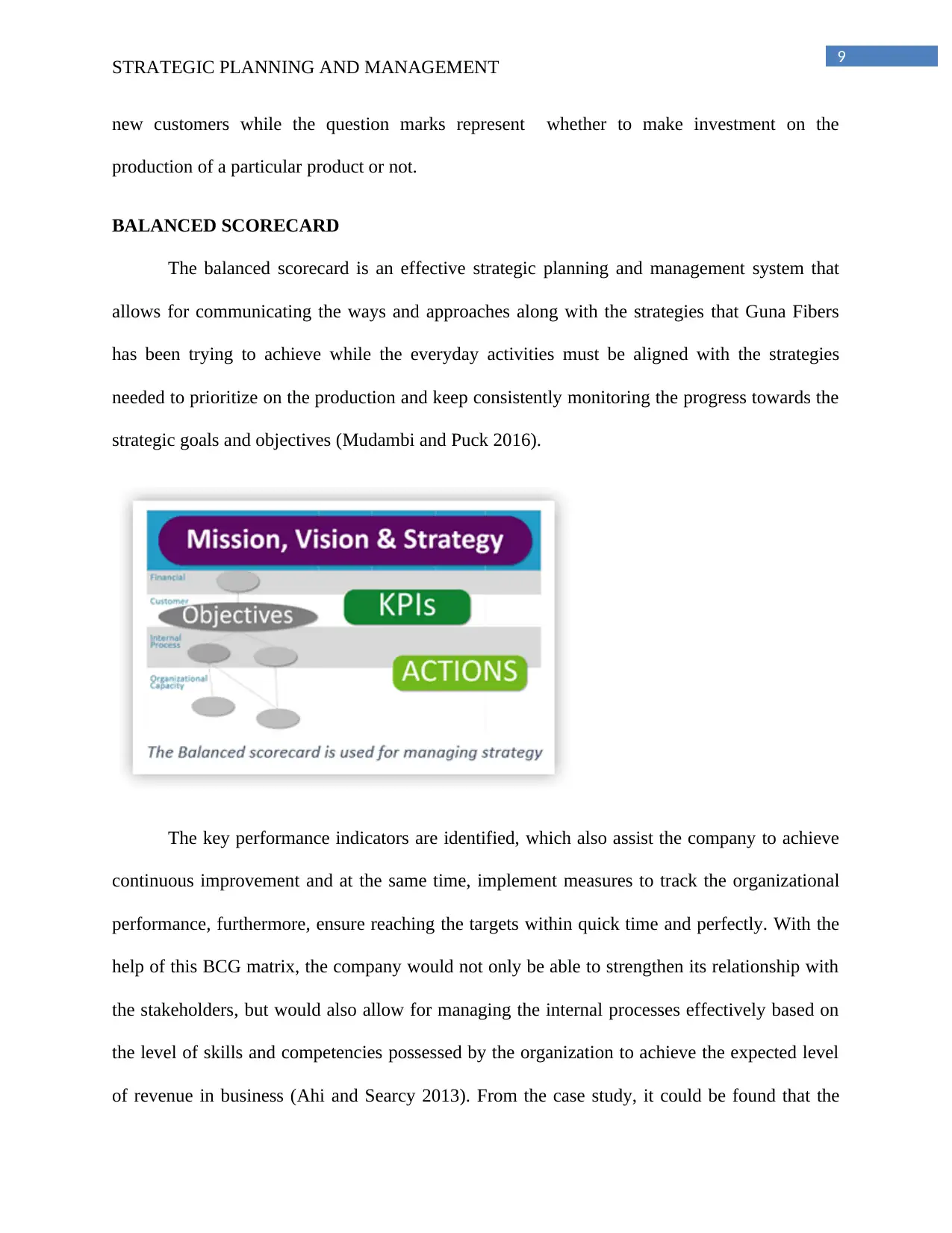
9
STRATEGIC PLANNING AND MANAGEMENT
new customers while the question marks represent whether to make investment on the
production of a particular product or not.
BALANCED SCORECARD
The balanced scorecard is an effective strategic planning and management system that
allows for communicating the ways and approaches along with the strategies that Guna Fibers
has been trying to achieve while the everyday activities must be aligned with the strategies
needed to prioritize on the production and keep consistently monitoring the progress towards the
strategic goals and objectives (Mudambi and Puck 2016).
The key performance indicators are identified, which also assist the company to achieve
continuous improvement and at the same time, implement measures to track the organizational
performance, furthermore, ensure reaching the targets within quick time and perfectly. With the
help of this BCG matrix, the company would not only be able to strengthen its relationship with
the stakeholders, but would also allow for managing the internal processes effectively based on
the level of skills and competencies possessed by the organization to achieve the expected level
of revenue in business (Ahi and Searcy 2013). From the case study, it could be found that the
STRATEGIC PLANNING AND MANAGEMENT
new customers while the question marks represent whether to make investment on the
production of a particular product or not.
BALANCED SCORECARD
The balanced scorecard is an effective strategic planning and management system that
allows for communicating the ways and approaches along with the strategies that Guna Fibers
has been trying to achieve while the everyday activities must be aligned with the strategies
needed to prioritize on the production and keep consistently monitoring the progress towards the
strategic goals and objectives (Mudambi and Puck 2016).
The key performance indicators are identified, which also assist the company to achieve
continuous improvement and at the same time, implement measures to track the organizational
performance, furthermore, ensure reaching the targets within quick time and perfectly. With the
help of this BCG matrix, the company would not only be able to strengthen its relationship with
the stakeholders, but would also allow for managing the internal processes effectively based on
the level of skills and competencies possessed by the organization to achieve the expected level
of revenue in business (Ahi and Searcy 2013). From the case study, it could be found that the
Secure Best Marks with AI Grader
Need help grading? Try our AI Grader for instant feedback on your assignments.
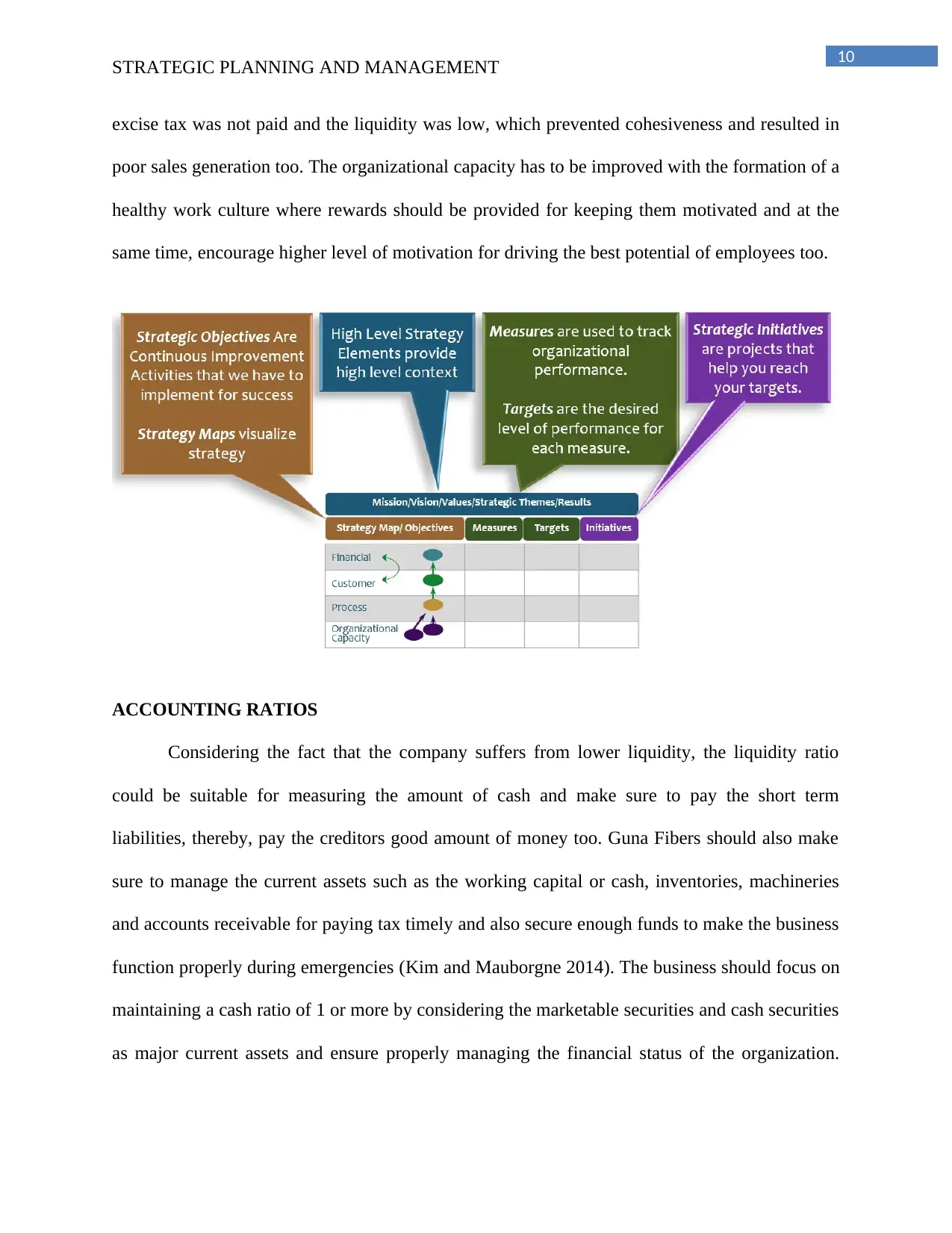
10
STRATEGIC PLANNING AND MANAGEMENT
excise tax was not paid and the liquidity was low, which prevented cohesiveness and resulted in
poor sales generation too. The organizational capacity has to be improved with the formation of a
healthy work culture where rewards should be provided for keeping them motivated and at the
same time, encourage higher level of motivation for driving the best potential of employees too.
ACCOUNTING RATIOS
Considering the fact that the company suffers from lower liquidity, the liquidity ratio
could be suitable for measuring the amount of cash and make sure to pay the short term
liabilities, thereby, pay the creditors good amount of money too. Guna Fibers should also make
sure to manage the current assets such as the working capital or cash, inventories, machineries
and accounts receivable for paying tax timely and also secure enough funds to make the business
function properly during emergencies (Kim and Mauborgne 2014). The business should focus on
maintaining a cash ratio of 1 or more by considering the marketable securities and cash securities
as major current assets and ensure properly managing the financial status of the organization.
STRATEGIC PLANNING AND MANAGEMENT
excise tax was not paid and the liquidity was low, which prevented cohesiveness and resulted in
poor sales generation too. The organizational capacity has to be improved with the formation of a
healthy work culture where rewards should be provided for keeping them motivated and at the
same time, encourage higher level of motivation for driving the best potential of employees too.
ACCOUNTING RATIOS
Considering the fact that the company suffers from lower liquidity, the liquidity ratio
could be suitable for measuring the amount of cash and make sure to pay the short term
liabilities, thereby, pay the creditors good amount of money too. Guna Fibers should also make
sure to manage the current assets such as the working capital or cash, inventories, machineries
and accounts receivable for paying tax timely and also secure enough funds to make the business
function properly during emergencies (Kim and Mauborgne 2014). The business should focus on
maintaining a cash ratio of 1 or more by considering the marketable securities and cash securities
as major current assets and ensure properly managing the financial status of the organization.
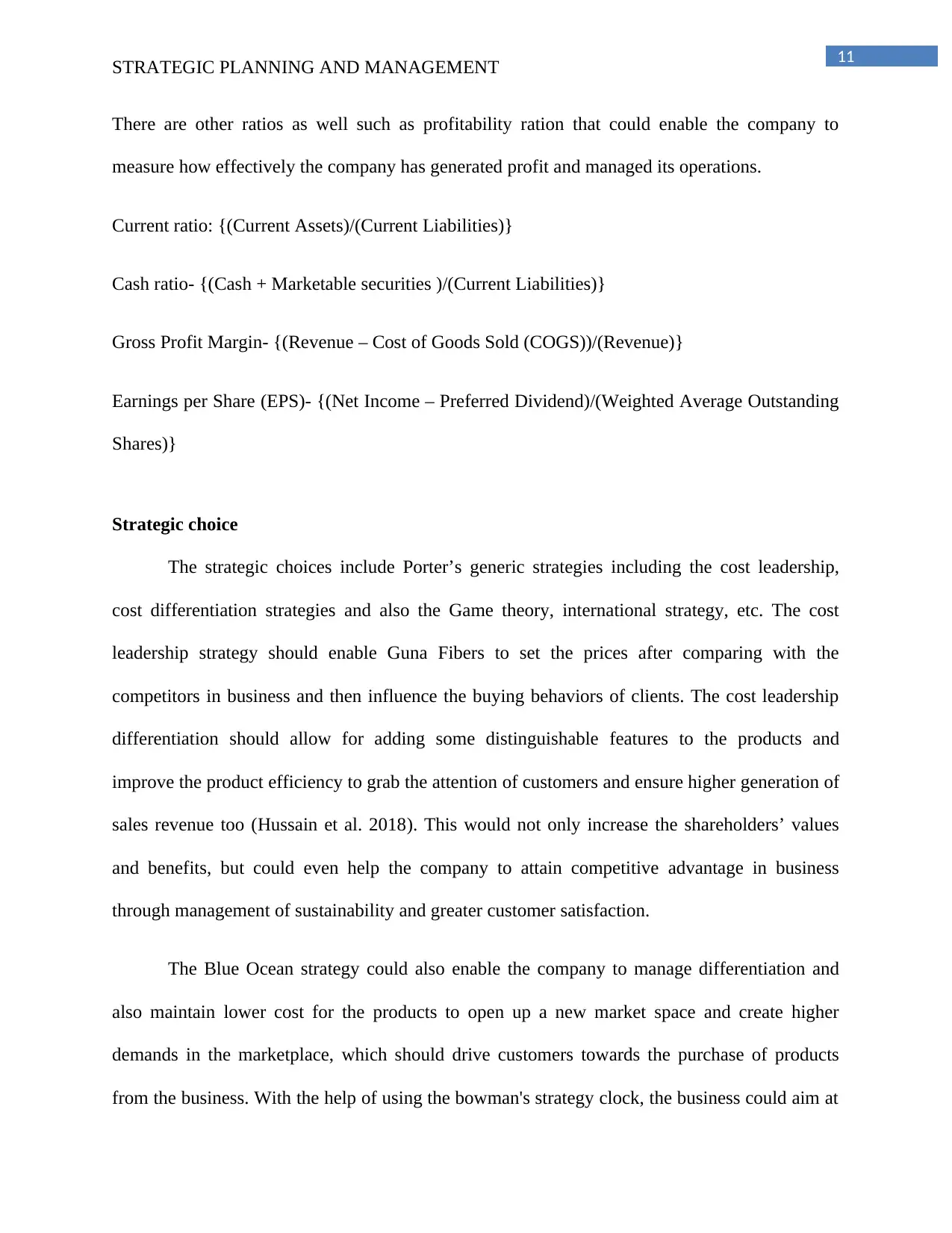
11
STRATEGIC PLANNING AND MANAGEMENT
There are other ratios as well such as profitability ration that could enable the company to
measure how effectively the company has generated profit and managed its operations.
Current ratio: {(Current Assets)/(Current Liabilities)}
Cash ratio- {(Cash + Marketable securities )/(Current Liabilities)}
Gross Profit Margin- {(Revenue – Cost of Goods Sold (COGS))/(Revenue)}
Earnings per Share (EPS)- {(Net Income – Preferred Dividend)/(Weighted Average Outstanding
Shares)}
Strategic choice
The strategic choices include Porter’s generic strategies including the cost leadership,
cost differentiation strategies and also the Game theory, international strategy, etc. The cost
leadership strategy should enable Guna Fibers to set the prices after comparing with the
competitors in business and then influence the buying behaviors of clients. The cost leadership
differentiation should allow for adding some distinguishable features to the products and
improve the product efficiency to grab the attention of customers and ensure higher generation of
sales revenue too (Hussain et al. 2018). This would not only increase the shareholders’ values
and benefits, but could even help the company to attain competitive advantage in business
through management of sustainability and greater customer satisfaction.
The Blue Ocean strategy could also enable the company to manage differentiation and
also maintain lower cost for the products to open up a new market space and create higher
demands in the marketplace, which should drive customers towards the purchase of products
from the business. With the help of using the bowman's strategy clock, the business could aim at
STRATEGIC PLANNING AND MANAGEMENT
There are other ratios as well such as profitability ration that could enable the company to
measure how effectively the company has generated profit and managed its operations.
Current ratio: {(Current Assets)/(Current Liabilities)}
Cash ratio- {(Cash + Marketable securities )/(Current Liabilities)}
Gross Profit Margin- {(Revenue – Cost of Goods Sold (COGS))/(Revenue)}
Earnings per Share (EPS)- {(Net Income – Preferred Dividend)/(Weighted Average Outstanding
Shares)}
Strategic choice
The strategic choices include Porter’s generic strategies including the cost leadership,
cost differentiation strategies and also the Game theory, international strategy, etc. The cost
leadership strategy should enable Guna Fibers to set the prices after comparing with the
competitors in business and then influence the buying behaviors of clients. The cost leadership
differentiation should allow for adding some distinguishable features to the products and
improve the product efficiency to grab the attention of customers and ensure higher generation of
sales revenue too (Hussain et al. 2018). This would not only increase the shareholders’ values
and benefits, but could even help the company to attain competitive advantage in business
through management of sustainability and greater customer satisfaction.
The Blue Ocean strategy could also enable the company to manage differentiation and
also maintain lower cost for the products to open up a new market space and create higher
demands in the marketplace, which should drive customers towards the purchase of products
from the business. With the help of using the bowman's strategy clock, the business could aim at
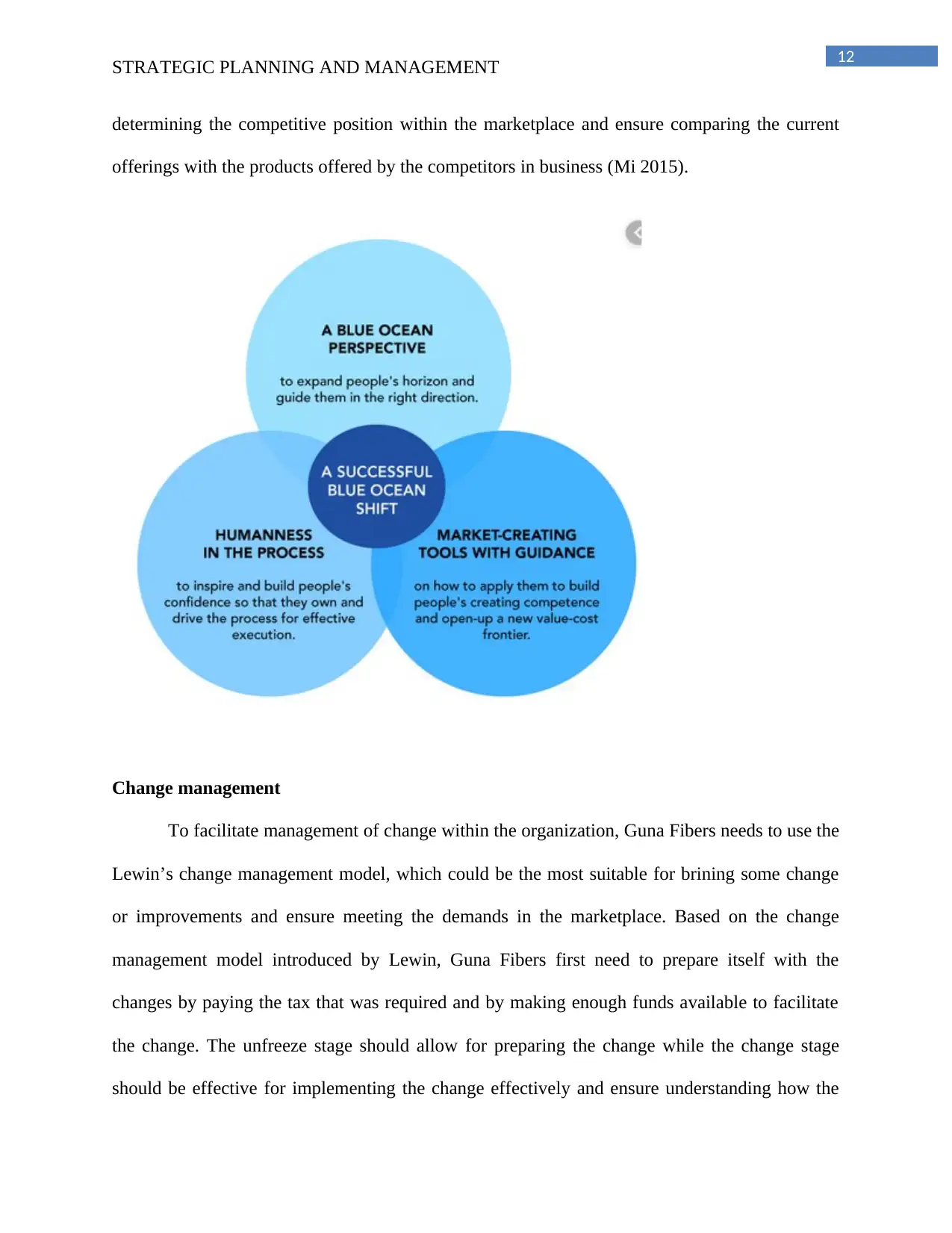
12
STRATEGIC PLANNING AND MANAGEMENT
determining the competitive position within the marketplace and ensure comparing the current
offerings with the products offered by the competitors in business (Mi 2015).
Change management
To facilitate management of change within the organization, Guna Fibers needs to use the
Lewin’s change management model, which could be the most suitable for brining some change
or improvements and ensure meeting the demands in the marketplace. Based on the change
management model introduced by Lewin, Guna Fibers first need to prepare itself with the
changes by paying the tax that was required and by making enough funds available to facilitate
the change. The unfreeze stage should allow for preparing the change while the change stage
should be effective for implementing the change effectively and ensure understanding how the
STRATEGIC PLANNING AND MANAGEMENT
determining the competitive position within the marketplace and ensure comparing the current
offerings with the products offered by the competitors in business (Mi 2015).
Change management
To facilitate management of change within the organization, Guna Fibers needs to use the
Lewin’s change management model, which could be the most suitable for brining some change
or improvements and ensure meeting the demands in the marketplace. Based on the change
management model introduced by Lewin, Guna Fibers first need to prepare itself with the
changes by paying the tax that was required and by making enough funds available to facilitate
the change. The unfreeze stage should allow for preparing the change while the change stage
should be effective for implementing the change effectively and ensure understanding how the
Paraphrase This Document
Need a fresh take? Get an instant paraphrase of this document with our AI Paraphraser
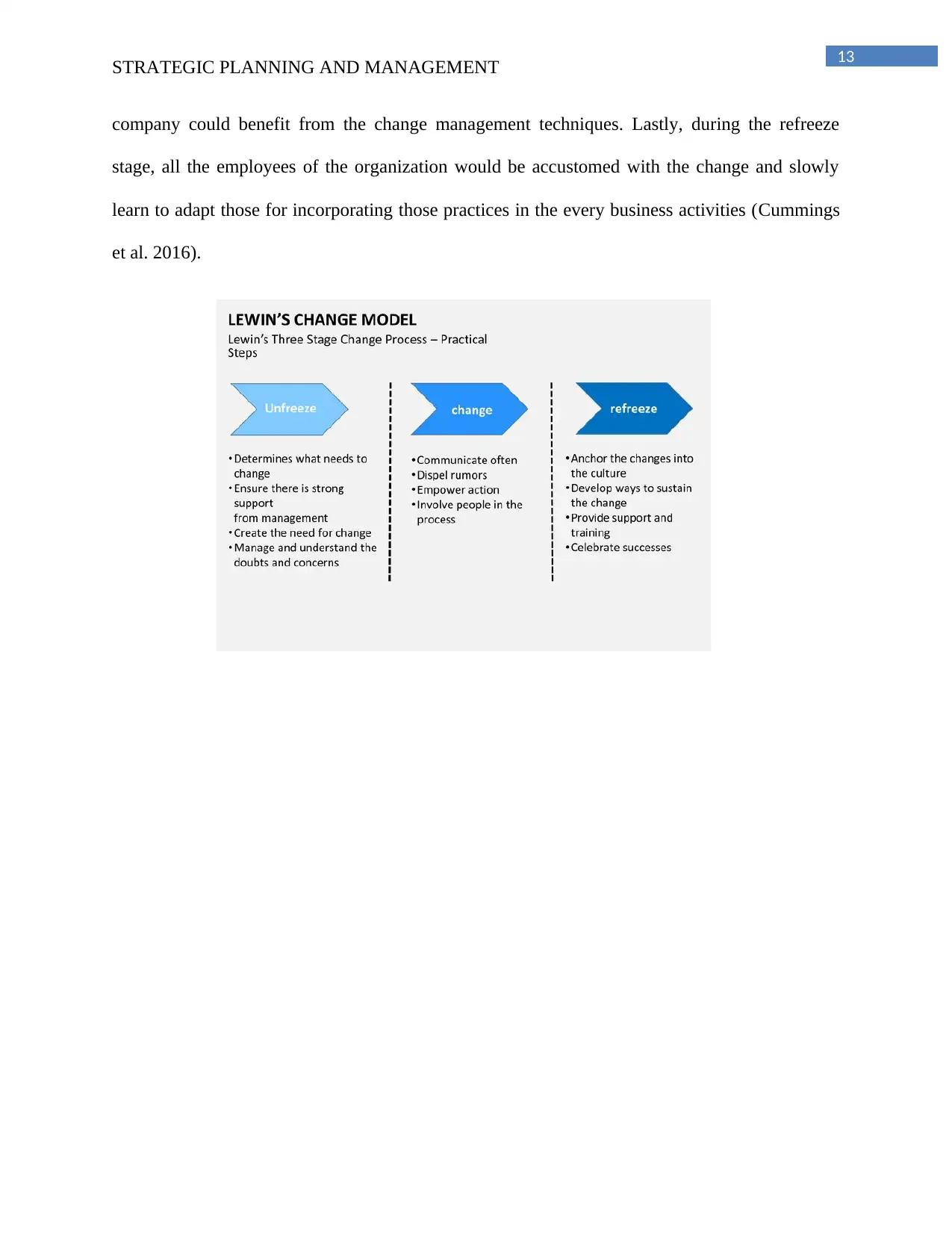
13
STRATEGIC PLANNING AND MANAGEMENT
company could benefit from the change management techniques. Lastly, during the refreeze
stage, all the employees of the organization would be accustomed with the change and slowly
learn to adapt those for incorporating those practices in the every business activities (Cummings
et al. 2016).
STRATEGIC PLANNING AND MANAGEMENT
company could benefit from the change management techniques. Lastly, during the refreeze
stage, all the employees of the organization would be accustomed with the change and slowly
learn to adapt those for incorporating those practices in the every business activities (Cummings
et al. 2016).
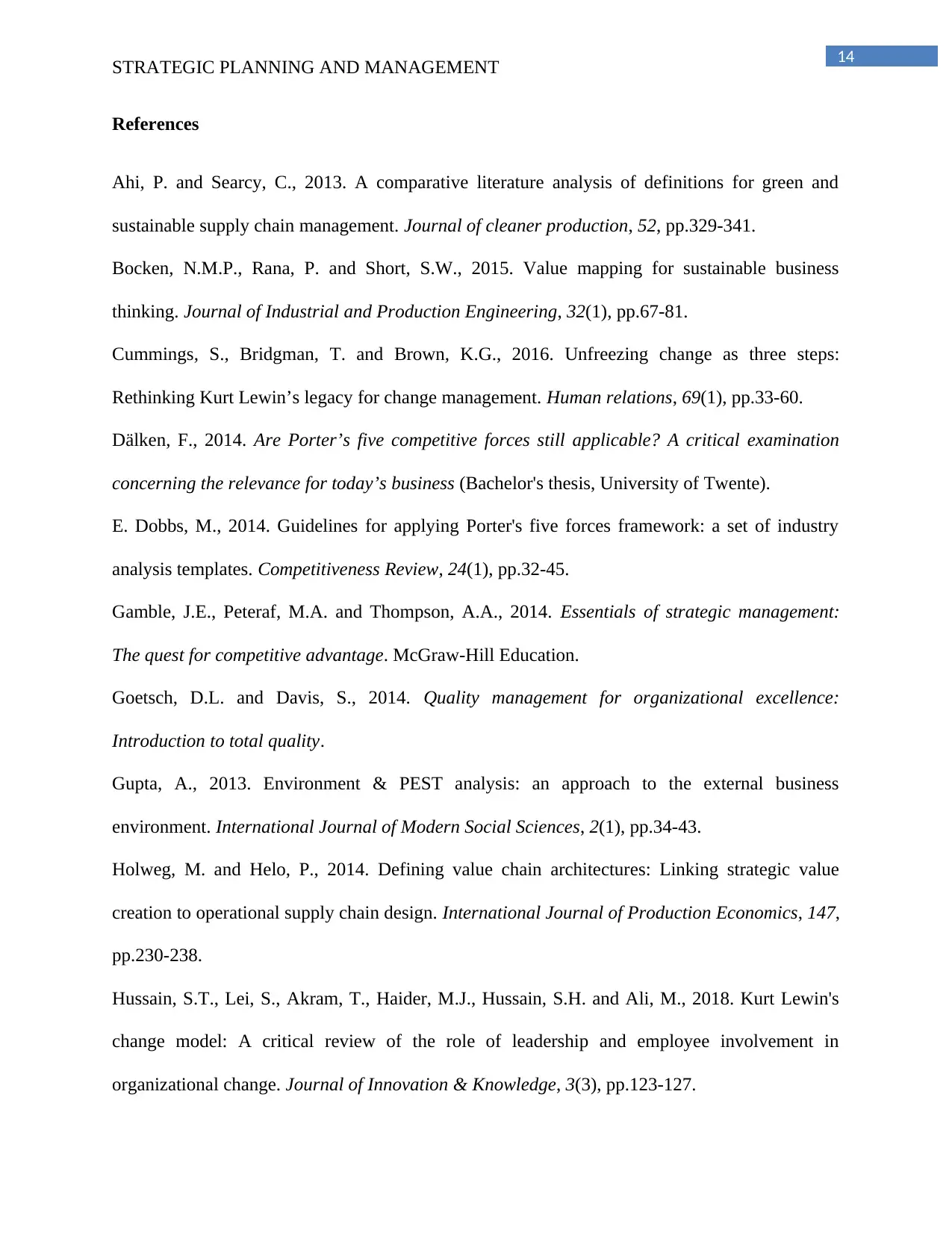
14
STRATEGIC PLANNING AND MANAGEMENT
References
Ahi, P. and Searcy, C., 2013. A comparative literature analysis of definitions for green and
sustainable supply chain management. Journal of cleaner production, 52, pp.329-341.
Bocken, N.M.P., Rana, P. and Short, S.W., 2015. Value mapping for sustainable business
thinking. Journal of Industrial and Production Engineering, 32(1), pp.67-81.
Cummings, S., Bridgman, T. and Brown, K.G., 2016. Unfreezing change as three steps:
Rethinking Kurt Lewin’s legacy for change management. Human relations, 69(1), pp.33-60.
Dälken, F., 2014. Are Porter’s five competitive forces still applicable? A critical examination
concerning the relevance for today’s business (Bachelor's thesis, University of Twente).
E. Dobbs, M., 2014. Guidelines for applying Porter's five forces framework: a set of industry
analysis templates. Competitiveness Review, 24(1), pp.32-45.
Gamble, J.E., Peteraf, M.A. and Thompson, A.A., 2014. Essentials of strategic management:
The quest for competitive advantage. McGraw-Hill Education.
Goetsch, D.L. and Davis, S., 2014. Quality management for organizational excellence:
Introduction to total quality.
Gupta, A., 2013. Environment & PEST analysis: an approach to the external business
environment. International Journal of Modern Social Sciences, 2(1), pp.34-43.
Holweg, M. and Helo, P., 2014. Defining value chain architectures: Linking strategic value
creation to operational supply chain design. International Journal of Production Economics, 147,
pp.230-238.
Hussain, S.T., Lei, S., Akram, T., Haider, M.J., Hussain, S.H. and Ali, M., 2018. Kurt Lewin's
change model: A critical review of the role of leadership and employee involvement in
organizational change. Journal of Innovation & Knowledge, 3(3), pp.123-127.
STRATEGIC PLANNING AND MANAGEMENT
References
Ahi, P. and Searcy, C., 2013. A comparative literature analysis of definitions for green and
sustainable supply chain management. Journal of cleaner production, 52, pp.329-341.
Bocken, N.M.P., Rana, P. and Short, S.W., 2015. Value mapping for sustainable business
thinking. Journal of Industrial and Production Engineering, 32(1), pp.67-81.
Cummings, S., Bridgman, T. and Brown, K.G., 2016. Unfreezing change as three steps:
Rethinking Kurt Lewin’s legacy for change management. Human relations, 69(1), pp.33-60.
Dälken, F., 2014. Are Porter’s five competitive forces still applicable? A critical examination
concerning the relevance for today’s business (Bachelor's thesis, University of Twente).
E. Dobbs, M., 2014. Guidelines for applying Porter's five forces framework: a set of industry
analysis templates. Competitiveness Review, 24(1), pp.32-45.
Gamble, J.E., Peteraf, M.A. and Thompson, A.A., 2014. Essentials of strategic management:
The quest for competitive advantage. McGraw-Hill Education.
Goetsch, D.L. and Davis, S., 2014. Quality management for organizational excellence:
Introduction to total quality.
Gupta, A., 2013. Environment & PEST analysis: an approach to the external business
environment. International Journal of Modern Social Sciences, 2(1), pp.34-43.
Holweg, M. and Helo, P., 2014. Defining value chain architectures: Linking strategic value
creation to operational supply chain design. International Journal of Production Economics, 147,
pp.230-238.
Hussain, S.T., Lei, S., Akram, T., Haider, M.J., Hussain, S.H. and Ali, M., 2018. Kurt Lewin's
change model: A critical review of the role of leadership and employee involvement in
organizational change. Journal of Innovation & Knowledge, 3(3), pp.123-127.
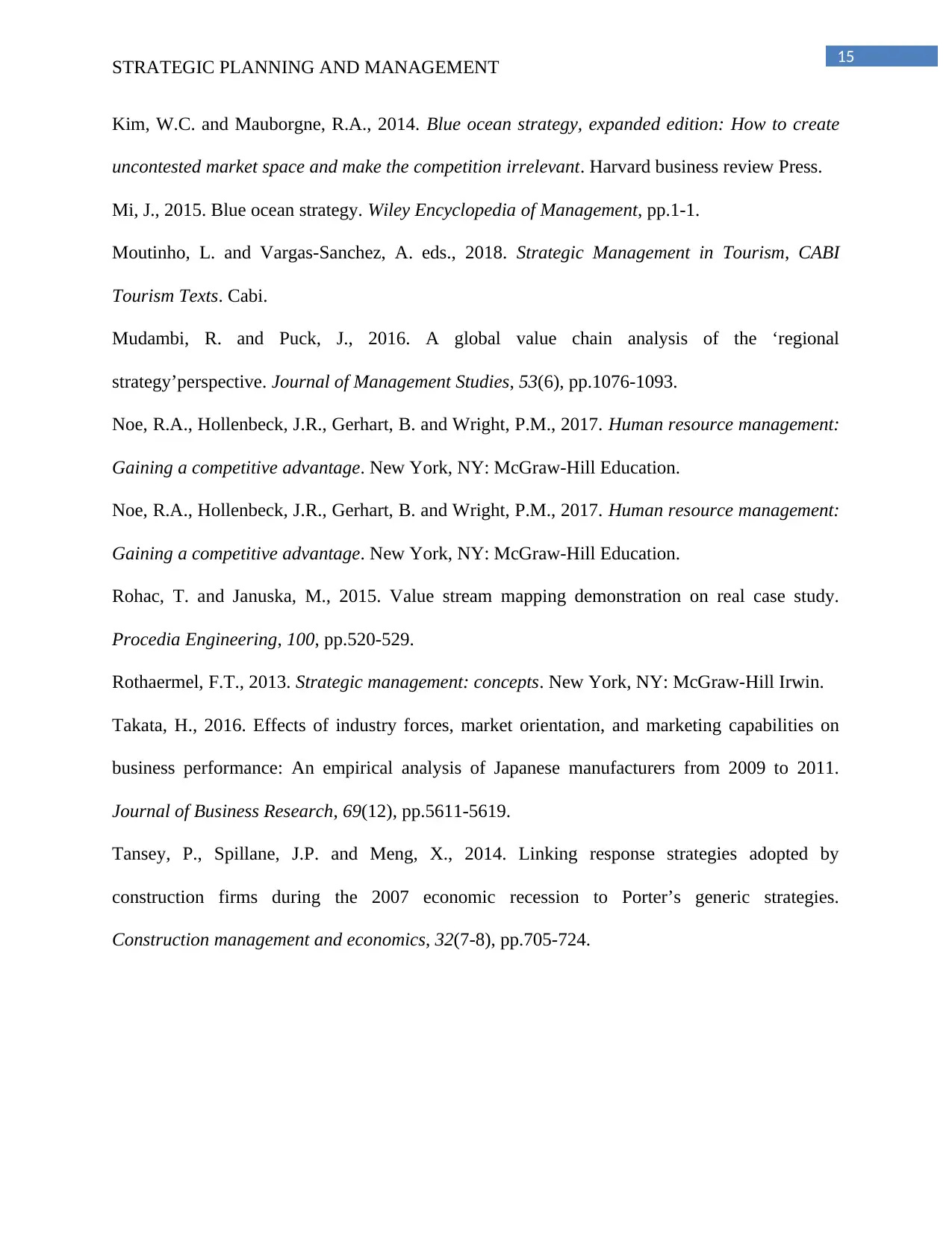
15
STRATEGIC PLANNING AND MANAGEMENT
Kim, W.C. and Mauborgne, R.A., 2014. Blue ocean strategy, expanded edition: How to create
uncontested market space and make the competition irrelevant. Harvard business review Press.
Mi, J., 2015. Blue ocean strategy. Wiley Encyclopedia of Management, pp.1-1.
Moutinho, L. and Vargas-Sanchez, A. eds., 2018. Strategic Management in Tourism, CABI
Tourism Texts. Cabi.
Mudambi, R. and Puck, J., 2016. A global value chain analysis of the ‘regional
strategy’perspective. Journal of Management Studies, 53(6), pp.1076-1093.
Noe, R.A., Hollenbeck, J.R., Gerhart, B. and Wright, P.M., 2017. Human resource management:
Gaining a competitive advantage. New York, NY: McGraw-Hill Education.
Noe, R.A., Hollenbeck, J.R., Gerhart, B. and Wright, P.M., 2017. Human resource management:
Gaining a competitive advantage. New York, NY: McGraw-Hill Education.
Rohac, T. and Januska, M., 2015. Value stream mapping demonstration on real case study.
Procedia Engineering, 100, pp.520-529.
Rothaermel, F.T., 2013. Strategic management: concepts. New York, NY: McGraw-Hill Irwin.
Takata, H., 2016. Effects of industry forces, market orientation, and marketing capabilities on
business performance: An empirical analysis of Japanese manufacturers from 2009 to 2011.
Journal of Business Research, 69(12), pp.5611-5619.
Tansey, P., Spillane, J.P. and Meng, X., 2014. Linking response strategies adopted by
construction firms during the 2007 economic recession to Porter’s generic strategies.
Construction management and economics, 32(7-8), pp.705-724.
STRATEGIC PLANNING AND MANAGEMENT
Kim, W.C. and Mauborgne, R.A., 2014. Blue ocean strategy, expanded edition: How to create
uncontested market space and make the competition irrelevant. Harvard business review Press.
Mi, J., 2015. Blue ocean strategy. Wiley Encyclopedia of Management, pp.1-1.
Moutinho, L. and Vargas-Sanchez, A. eds., 2018. Strategic Management in Tourism, CABI
Tourism Texts. Cabi.
Mudambi, R. and Puck, J., 2016. A global value chain analysis of the ‘regional
strategy’perspective. Journal of Management Studies, 53(6), pp.1076-1093.
Noe, R.A., Hollenbeck, J.R., Gerhart, B. and Wright, P.M., 2017. Human resource management:
Gaining a competitive advantage. New York, NY: McGraw-Hill Education.
Noe, R.A., Hollenbeck, J.R., Gerhart, B. and Wright, P.M., 2017. Human resource management:
Gaining a competitive advantage. New York, NY: McGraw-Hill Education.
Rohac, T. and Januska, M., 2015. Value stream mapping demonstration on real case study.
Procedia Engineering, 100, pp.520-529.
Rothaermel, F.T., 2013. Strategic management: concepts. New York, NY: McGraw-Hill Irwin.
Takata, H., 2016. Effects of industry forces, market orientation, and marketing capabilities on
business performance: An empirical analysis of Japanese manufacturers from 2009 to 2011.
Journal of Business Research, 69(12), pp.5611-5619.
Tansey, P., Spillane, J.P. and Meng, X., 2014. Linking response strategies adopted by
construction firms during the 2007 economic recession to Porter’s generic strategies.
Construction management and economics, 32(7-8), pp.705-724.
1 out of 16
Related Documents
Your All-in-One AI-Powered Toolkit for Academic Success.
+13062052269
info@desklib.com
Available 24*7 on WhatsApp / Email
![[object Object]](/_next/static/media/star-bottom.7253800d.svg)
Unlock your academic potential
© 2024 | Zucol Services PVT LTD | All rights reserved.





